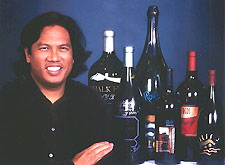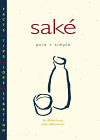|
from the Melting Pot of the Pacific
According to Frost, "the fine qualities of premium sake is destroyed when it is heated ... only the lowest quality sake is served warm." Even though, he allows, some 60 percent of the sakes in the world still fall into that category. But about 20-25 years ago, technology, as well as a growing artistic sensibility, began to allow sake producers in Japan to brew far more subtle, drier products with flavors more distinctly of rice, "stony brooks," and even fresh fruit nuances. These types of sake are referred to as hiyazake or reishu, and are served either at room temperature or lightly chilled to highlight their purity and freshness. When I visited SakeOne last week, one whiff of a slowly fermenting vat of premium sake -- smelling, for all the world, like a giant bouquet of fresh, sweet honeydew melon, pineapple, passionfruit, jasmine and vanilla beans -- and I was definitely convinced of that. Premium quality sake is a refined and delicate thing, very much like fine wine! Which brings us to another question: is sake a "wine?" Well, yes and no. Yes, from the perspective that, like wine, its alcohol level is the result of the conversion of sugars to alcohol by the action of yeast. Wine, of course, is fermented from natural grape sugars; whereas sake is fermented from finely polished (to less than 65 percent to 50 percent of the original hull size), steamed rice which has had its starchy core converted into sugars through a painstaking process called koji making, done largely by hand in special, warm, steamy, wood paneled rooms. A sake-making facility, however, is referred to as a brewery, or "kura." But unlike beer, which usually finishes at 3 percent to 6 percent alcohol, sake naturally finishes at around 14 percent to 17 percent -- more like wine made from grapes, but obviously tasting less fruity, and more subtly scented. And of course, if you ask the Bureau of Alcohol, Tobacco and Firearms, you'll find that for taxation purposes sake is classified as a wine. And who's to argue with that? Whatever the case may be, just as the revolution in sake production and appreciation began in Japan two decades ago, the same thing has been taking place up there in Forest Grove these past two years. There, Frost is leading the way with first-time-ever production methods such as use of computers to monitor and control milling, steaming and fermentation processes, plus the exclusive usage of strictly sake rices (out of the hundreds grown, mostly for food consumption) such as Akita Komachi and Yamada Nishiki. The latter, in fact, is known in Japan as the "king" of sake rices, and the first crop grown in the U.S. (in California's Sacramento Valley) was only harvested this past year.
Things that I've learned after only an hour of talking to Frost? For one thing, that sake shouldn't be drunk with rice or sushi, as popularly believed. To the Japanese, this is almost be like drinking wine with grapes. Frost recommends starting a meal with a beer (to freshen the palate); and then with sake, going to foods like pickled vegetables, pork, chicken, shellfish, and fish (grilled or sashimi), before finishing with sushi. And although premium sakes are virtually "hangover free," according to Frost (since hangovers are largely caused by impurities in alcoholic beverages, which in premium sakes are removed in the milling process), he quotes the traditional Japanese warning: "Sake starts out as a friend but can end as an enemy." But oh, what an amiable enemy. Here are some notes on the pure, Oregon brewed sakes produced by SakeOne under the Momokawa label, all of which retail for between only $9 and $12 (per 750 ml. bottle) across the country: Momokawa "Diamond" - SakeOne's top-of-the-line, which is smooth, easy, yet full tasting (15% alcohol) on the palate; a flowing, stony dry taste that is excellent with grilled meats and pan fried seafoods. Momokawa "Silver" - My second favorite of the dry styles; crisper and a trace more appley-acidic than the "Diamond"; clean, moderately full, with subtle rice and mineral tones that should do well with sashimi, tempura, and white meats. Momokawa "Pearl" - Although lightly and perceptively sweet, this is a luscious, well balanced sake with a white, "cloudy" look (due to a rough filtration which leaves in much of the milky white lees), and a creamy, almost coconut-like flavor; highly recommended with chili spiced foods like schichimi coated fish, satays, curries, and even kim chee! Under the Moonstone label, SakeOne also produces an array of what Frost calls "Infused Sake." These are flavored sakes -- much like fruit flavored wines -- which may strike sake purists as aberrations, but which Frost believes performs the critical task of introducing the joys of sake to the unfamiliar masses (much like coolers and White Zinfandel has done for premium wine). The best parts are that they are priced at a very friendly $8-$9 per bottle, their alcohol levels are only 13.5%, and like any premium sake, they are best enjoyed well chilled. My three favorites: Moonstone "Yuzu" - A lime flavored sake with a lovely, fresh, penetrating citrus perfume, a fine and zesty, off-dry taste, and a bracing, citrus vodka-like edge that works great with Mexican food, barbecues, salads, or (mixed with a little sparkling water and citrus wedges) a hammock under the shade. Moonstone "Asian Pear" - A very subtle infusion of pear flavor makes this more pure sake-like when it enters the palate -- soft, easy, slightly sweet -- and finishing with a crisp, pear-like fruitiness. Frost says this is easily appreciated by most white wine lovers. Moonstone "Hazelnut" - A lovely, ringingly fresh, hazelnut scent with vanilla bean and caramel nuances, followed by a palate freshening, off-dry taste. Frost recommends this with chocolate and pastries. I'm thinking, anytime-anyplace -- never a bad time when it comes to honestly made sake! (If you'd like to visit SakeOne's Website, it's at www.sakeone.com/. Sept. 16, 2000
|
 Sake - The "Wine" of the Future?
Sake - The "Wine" of the Future?